#mina: meta
Text
I just...I just...Eowyn slew the Witch King of Angmar.
Eowyn married Faramir.
Faramir was made Prince of Ithilien. One of his duties was rehabilitating Minas Morgul.
Minas Morgul which was once ruled by the bloody Witch King of Angmar.
There's just too many thoughts there. Like, was Aragorn thinking, Eowyn did a bloody good job destroying the Witch King, let's see her get rid of the remains of his evil.
Eowyn riding into Minas Morgul, knowing that the monster who ruled there had died at her hands. The land itself, the remnants of the Witch King and the life that is choked by it, responding to her presence, the Maiden of the Shield Arm. Eowyn's wounds affected by riding into the land where the Witch King's evil still lingered. Eowyn fighting to see the land torn down and rebuilt, healing herself by healing the city.
Eowyn's endgame, her married life, fighting to reclaim the land from the hands of the monster who killed her uncle, but couldn't kill her.
2K notes
·
View notes
Text
I think it’s fascinating that the original horror of dracula is kinda lost on us because our cultural well has been poisoned. I don’t know any 6-year olds who can’t tell you vampires are EVIL or are unfamiliar with the name dracula. Reading the first chapter and seeing Johnathan, our beloved, think about asking his new friend COUNT DRACULA for help is comedic! Of course he’s walking into danger. We’re genre aware.
However, also while doing dracula daily, there’s a new kind of horror. Both the prolonged no knowing when the next entry will drop but the sadness and horror of having to sit with the characters and wanting so desperately to give our heroes a metaphorical rosaries to protect them. We know this is a sinking ship full of vampires, we know how dangerous the situation is, how woefully unprepared everyone else is.
Which brings me back to how the dynamic has shifted, and I think unexpectedly so. Originally, dracula’s horror comes from the audience being basically London. He is scary because it’s unnerving to discover what new and terrible calamity is coming. What new powers and murderous feeding will come next? Who exactly are we locked in this room with? Will we make it out alive? But now, the horror stems from the audience being the Transylvanians, desperately longing to catch Jonathan before he gets to the carriage, begging him to turn back now. We are condemned to watch the ship as everyone gets picked off one by one. It’s a different but equally visceral kind of horrorshow.
#dracula daily#dracula#meta#dracula daily meta#daily dracula#mina#jonathan#horror#van helsing#vampire#vampires#wwdits#because I think it also serves as an interesting mirror to the og dracula#Bram Stoker#fandom#does it count as fandom if it's a classical 1800's novel?#count dracula#lucy
9K notes
·
View notes
Text
one thing I suddenly got very not-normal about is how mina is, of course, praised for her gentle heart, but her resolute mind also, and she is called gallant, and she is often described with words / emotion that the novel usually saves for men – to the point when van helsing says:
Ah, that wonderful Madam Mina! She has man's brain, a brain that a man should have were he much gifted, and a woman's heart.
and I was thinking how this was gradually introduced, but then actually, no
she has been our dear mina forever, but her full name is masculine in roots: wilhelmina. a female derivative of wilhelm (wilhelm, or william, the conquerer is the first who jumps to mind). and you know what the name means? resolute protection. she has always been there, a quiet warrior, a true protector, even when she herself was being protected – and she never asked her men to protect her. they just collectively decided to, and it was bittersweet and wholesome, but mina was anxious for action too. she, in fact, kept working her best to protect her mancrowd in the meantime. she was giving instructions, using imperatives right and left, strategizing like a war general.
it's just so dear to me that wonderful madam mina is there, but there is also hiding in her that feral side, commanding respect on a whole other level, that makes men count her equal. my feral wilhelmina is the best.
#dracula#dracula daily#re: dracula#mina murray#mina harker#wilhelmina#dracula meta#abraham van helsing#september 30
411 notes
·
View notes
Text
The thing that kills me about the Oct 11th entry with Mina insisting that should she turn into a vampire, she wants the others to kill her, is not just that Jonathan does not promise to do that, but that the way we hear Seward describe the scene—Quincy promising first, Jonathan brokenly asking if he has to and hesitating, the way we know about Jonathan’s private holy vow to Mina in his journal—is that I wonder if Jonathan is drawing his line in the sand.
He’s already made up his mind about what he will do if Mina turns, and now with Mina making the suitor squad promise to kill her, I wonder if now his fear and intention has subtly shifted.
You can almost hear it in that scene as Seward is describing Jonathan’s body language, but as soon as Quincy steps up to make his vow, I can almost sense the shift radiating off Jonathan.
He now has to contend with not only Dracula, but if it comes down to it, also against everyone else there, because he cannot allow Mina to come to harm, by any hand, especially not his own.
I think he was re-evaluating his priorities and loyalties. Yes, he is friends with all these people and loves them and wants them to work together to defeat Dracula and save Mina, but now he has resolved to the fact that there is a possibility of a last stand of “us” (him and Mina) vs. “them” (suitor squad), even if it’s not what Mina wants, he would do anything to keep her safe.
And if you follow the subtext that Jonathan was bit too, he knows he’s on limited time as well at this point, if he even remembers being bit, but regardless would let Mina turn him if he didn’t remember. He knows killing her would not save him like she thinks it would, besides the fact that doing so would destroy him. He would rather be rest assured in the damnation of his own soul than have it utterly destroyed in the act of ending Mina’s life. I don’t think he could go on, and I think he would find it useless regardless, because he would rather die than kill Mina.
And he would rather harm everyone else than let anymore harm come to Mina, even if that means he has to cut down those nearest to him if it means saving her.
When he promised to himself to let himself become undead with her, he’s not only damning himself and Mina, but the whole of London and beyond. And if he’s willing to let the world burn for Mina, I’m willing to bet he’d let his friends burn too.
He now has an ulterior motive and while everyone else will be keeping a close eye on Mina, he will be keeping a close eye on everyone else, because he can no longer trust them not to follow through on their promise to her.
He doesn’t promise.
He won’t kill her.
And you’ll have to go through him if you want to try.
#dracula daily#October 11#Dracula daily October 11#jonathan harker#mina harker#mina murray#quincy morris#van helsing#john seward#jack seward#lord godalming#re: dracula#Dracula#bram stoker#dracula daily meta#dracula meta#dracula analysis#my post#original post#skele talks#skele post#gOD THEYRE SO XISNXJANBISSKXJAKXNS THEY MAKE ME INSANE RRRRRRRRGGGGGGGGAAAAAAHHHHHHH#jonathan x mina#holiest love
570 notes
·
View notes
Text
"Right over the town is the ruin of Whitby Abbey, which was sacked by the Danes, and which is the scene of part of 'Marmion,' where the girl was built up in the wall."
there's a beautiful sort of irony that, in 1897, Mina was excited to visit the ruins of Whitby Abbey, not for the historic church itself, but because it was in her fave gothic novel, Marmion...
... and now, over a hundred years later, tourists from around the world visit Whitby Abbey, not for the historic church itself, but because it was in their fave gothic novel Dracula
#dracula daily#dracula#re: dracula#bram stoker#mina harker#mina murray#dracula meta#dd july 24#july 24#dracula july 24
441 notes
·
View notes
Note
I saw your DD graph asking for other ideas, so... if you still have any desire to do further Dracula graphs I'd be curious to see how the word count per character breaks down (not how much they speak but how much they write. Adding all their diary entries together, etc.). Obviously Mina wins by default from having typed up the whole novel but outside of that detail, how much did each person author?
Thank you so much for this ask! What an interesting data set this one is! Lots of unexpected information.
So first off, if you just want to visualize the author breakdown, ta-dahhhh!

Seward was staunchly in the lead, talking his head off and burning through those wax recording drums like no ones business. Poor Mina for having to transcribe it all. In total his words made up 39.3% of Dracula. Nearly 40%!
Seward unsurprisingly had the most individual entries overall at 47, and had the longest streak for being the narrator in an entry at 10 days (09/02 - 09/11) with Mina following right behind at 9 days (08/10 - 08/19)
Mina surprisingly was 3rd overall both in word count and number of entries. She wasn't even in the top 3 for most words in a day which is as follows.
1 - Seward October 3rd - 9942 words
2 - Seward September 29th - 7206 words
3 - Jonathan October 3rd - 5944 words
Van Helsing only had 9 entries total but still came in number 4 for word count, in front of Lucy. It's interesting to note that the amount a person writes doesn't correlate to the amount of time they are being written about/appear. Which is why Arthur and Quincey don't even beat out the newspaper clippings for words, lol.
There are lots of authors we only hear from a single time, like Sister Agatha. So I've decided to make a small fry pie as well. (Authors under ~500 words)
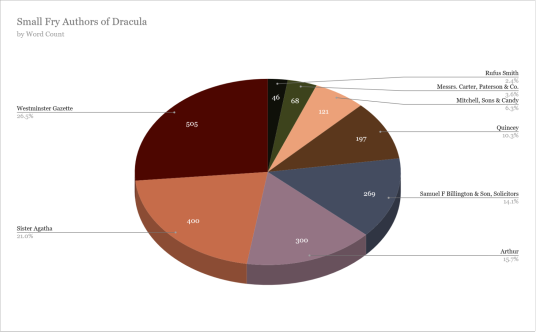
The captain of the Demeter and Van Helsing both had more days written than Lucy! Though I didn't break up number of entries, like when the log of the Demeter had 3 or 4 on one day or Lucy wrote a letter and in her diary.
If there is any data I haven't presented here that you're interested in feel free to tag me or shoot me an ask like this lovely person did!
#dracula daily#this took me 4 hours#potential spoiler#graphs#book data#word count#meta#averages#percentages#dracula daily tracker#dracula entry lengths#dracula authors#dracula meta#jonathan harker#mina harker#john seward#abraham van helsing#mina murray#lucy westenra#dracula#bram stoker#marketpeaches#arthur holmwood#van helsing
388 notes
·
View notes
Text
On Horror, Queerness, Mirrors, and Dracula



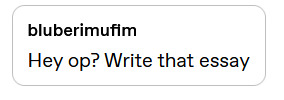

Your wish is my command (you may or may not regret this).
Here’s the thing - I love horror, and I love patterns, and I think the best horror is always in some sense symmetrical. It might not be obvious, but what’s the point of staring into an abyss if you can’t see your own face reflected back? The symmetry itself comes in any number of different twists, whether it is familial, communal, erotic, or individual, and most of these apply to Bram Stoker’s Dracula.
The centre of our novel rests on the Harkers. So, starting with Jonathan - his experience in Transylvania is a twisted version of his life back home. Dracula is reserved but eloquent, seemingly caring and occasionally affectionate, he reads train schedules and they spend hours upon hours in conversation; which is a dark mirror to Jonathan’s train schedule-loving, passionate but serious Mina. It may even be said that the Count is re-enacting a caricature of traditional heteronormative domesticity - he maintains the household, waits on his guest himself, and blows him kisses from the stairs. His possessiveness of Jonathan is the only way a vampire like Dracula is capable of understanding the bond Jonathan shares with Mina. The Count states that he, too, feels love; but he is written by a closeted gay man in the late 19th century, so his imitation of married life is both a lie and a tragedy. He is a shorthand for forbidden, wrong, and corrupting desires.
At the same time, Mina herself also has a same-sex connection in the beginning of the story, and her relationship with Lucy mirrors the relationship between Jonathan and Dracula. They cling to each other, in a sense; despite being excited about the prospect of their impending marriages, there is some trepidation associated with this new stage in life. A common part of a dowry used to be a shroud, simply due to the frequency at which Victorian wives died in childbirth soon after the wedding; and even provided a survival, the transition to married life was still a loss of innocence. As such, Lucy’s affection for Mina is the last expression of her girlhood, and she herself is the personification of Mina’s. Lucy is, therefore, the direct antithesis of the Count; her death and subsequent rising change Mina the same way that Dracula does Jonathan, establishing a firm duality between the Harkers and their respective vampires.
The other characters are reflections of each other, as well; the suitors defend while the brides terrify, Van Helsing wants to preserve life while Renfield wishes to consume it - and even further, the old Hungarian lady cares enough about a stranger to give Jonathan a cross for protection, while Lucy’s own mother lets Dracula into the house herself, selfishly ignorant of her daughter’s needs and the doctor’s orders. Another parallel is drawn again between Jonathan and Renfield, who represents directly what he could have been, had he not escaped from Dracula’s grasp; which makes Renfield’s vehement, last-ditch attempt to protect Mina perhaps all the more poignant. In him, she sees the resilience of Jonathan’s humanity; while he gets to see exactly what she could become after her turning - in Dracula himself. These dualities are integral to the story’s thematic structure, and therefore inextricable from each character’s development.
There is really too much to say about each individual dynamic to fit into one rant, but for the current purposes, I can forgo the details. They all converge as it is on Jonathan and Mina, and thus, the central theme of this story is devotion. If Jonathan had truly broken, like Renfield, Mina would have stayed by his side; and if she had fully turned, like Dracula, he would have adored whatever shred of her still remained. In madness and in death, in happiness and sorrow, in sickness and in health - until the echoes start to sound like wedding vows.
@stripedshirtgay
@bluberimufim
#dracula#dracula daily#jonmina#jonathan harker#mina harker#dracula meta#bram stoker#y'all asked for this#now scream with me bc i've been internally screaming about this for years#it's about the DEVOTION#lucy westenra is mina's innocence#dracula is jonathan's fear of inadequacy#renfield is his humanity#dracula is an evil version of mina i said what i said#that's Partially why jonathan wasn't weirded out enough#like yes yes eccentric old count#but he writes a diary in shorthand#and his fiancee loves train schedules#who's he to judge
477 notes
·
View notes
Note
Good observation that Dracula's great grimness at informing Jonathan that they must part soon changing to his usual smoothness when Jonathan refuses to return to his room as dictated. Or gives Dracula the pleasure to go "before we part and before you become one of us let's play one more time, lets see you walk back into my arms from danger once more, for good this time". Maybe he even expected this small rebellion from Jonathan, knowing him. Especially after he dared scale his walls. It's more satisfying to "earn" Jonathan's submission. An unbreakable will bending to his is sweeter.
I think Dracula absolutely loves Jonathan's stubbornness... but only with the caveat that he is in control of the situation and can prey upon it. This response is extremely belated, but I kind of like answering it now because I think Dracula's treatment of Renfield so far, as opposed to Jonathan, is so revealing. He's ignoring Renfield completely. He has no interest in him at all. Because Renfield wants to be with Dracula. And Dracula doesn't care to spend his time with people who want to be around him; he's only interested in forcing his company upon those who don't want it. It's a huge part of the fun for him.
If someone like... Seward, for example, had been sent to Castle Dracula, he wouldn't have lasted anywhere near as long. Because I think he would be too enticed/interested in the vampires, and thus he'd bore Dracula a lot faster by being too willing or even eager to play along. Then again, someone who refused to play along at all would get boring very quickly too - if they don't submit and play his game he'll force them into submission with violence and that'll be the end of it. Jonathan managed to thread the needle perfectly with playing along on the surface while still constantly trying to resist behind the scenes. It was interesting and fun, a challenge that never made Dracula feel truly threatened. (Of course, he didn't realize the full extent of Jonathan's resistance/that he did have cause to be threatened...)
And he loved it! He was having so much fun! He got to genuinely enjoy Jonathan's company, but also enjoy how little Jonathan enjoyed his company and how he couldn't do anything about that. He got to keep pushing and pushing and pushing him and watch Jonathan almost break again and again but still just keep bending. To tempt him into disobeying and then punish him for it. To force him to rely on Dracula himself for protection and thus stick even closer the more endangered he gets. He gets to work for it, while at the same time never actually facing real risk other than losing his new toy (and Jonathan always settled down in the end, always let the game continue). ...And then he had to call it quits, because he had a schedule to keep. Yeah, I think he was genuinely kind of upset about that. And so when he got the idea for the wolves, he cheered way up again.
Because Dracula was able to offer Jonathan exactly what he claimed he wanted, but in such a way that they both knew he would never accept it. Instead, he forced Jonathan into a situation where he was forced to "choose" Dracula instead, one last time and more definitively than ever before. It was the perfect way to end their time together. Well, except one final victory - 'rewarding' Jonathan's choice by honoring it with one last night together, with delaying no longer and finally drinking from him.
Contrast all of that to Dracula's complete disinterest in Renfield, despite his avowed goal of conquering England and spreading vampirism here. You'd think a servant who willingly came to him would be helpful for that. But no, because Renfield came to him truly willingly, wanted to enter freely and of his own accord.
Dracula likes the kind of person who enters freely and of their own accord... because they're alone in the wilderness with wolves at their back. He likes those who stay because doing otherwise would be their certain death. He likes those who don't want this (who struggle and struggle, who have an unbreakable will) and yet are forced by him into accepting anyway.
An unbreakable will who bends at his command - that's how Dracula saw Jonathan, and he loved him for it. Right up until the point he decided he was finished, and acted to break him once and for all anyway.
#dracula daily#count dracula#jonathan harker#renfield#anonymous#replies#LITTLE DID HE KNOW THOUGH#sure he broke him a little but not completely. jonathan made it out and now he's got mina#my meta
225 notes
·
View notes
Text
Been reading some takes on the emasculation of Jonathan and erasure of the suitors in adaptations because they draw focus away from Big Daddy Alpha Dracula and it just makes me feel a way... This is a book about Mina but it is also about men and these many very different ways to be a Good Man from Jonathan who is meek but kind and honest and true, Quincey who is reckless but loyal and brave, Seward who is melancholy and at times arrogant in his intellect but also absolutely determined to use his knowledge to help, heal and understand others...
And then you have Dracula, who is at his core a selfish monster, who preys on the weak, who abuses women and turns them into his slaves, who takes advantage of and subsequently discards the poor and ill.
Here we have a clear cut dichotomy between positive and toxic masculinity in full display, honestly STILL a timely story to be told over a century later. And yet everybody makes the story about sexy hot alpha male Dracula and then creates a half-baked good-bad dichotomy between the two women instead.
#Dracula#Dracula Daily#Dracula Spoilers#Stories#Meta#Dracula is over a hundred years old and we're STILL SEEING this focus on irredeemable villains and making them sexy and palatable#at the expense of the heroes#and then completely throw the women under the bus to further service their villain's narrative; make Lucy BAD and that's why he hurt her#and Mina is GOOD and that's why he loves her#it's all about him
229 notes
·
View notes
Note
What do you think Class 1-A's action figures would look like in universe?
Non-quirk related question haha. What do you think class 1A's barbie-ken taglines would be? Not sure how to frame the question but for example for Tokoyami it could be, "This Ken is gothic" or for Ochako it could be, "This Barbie is on cloud nine" (due to her quirk)
I mean, I'm not sure if there is much to say on that. I feel like any taglines for actions figures would just be pretty generic, but I can talk about action figures.

Sato: Comes with a series of small snacks that you can feed him to cause him to bulk up and you pop open the stomach to get them back.
Koda: Just a simple figurine of him with a bunch of small animal models that you can play with as well. Comes with a button to play animal sounds.
Mineta: Orbs on the head are removable and the toy comes with arms that catapult the orbs forward. Possibly with a pointless target pad that no kid will use.
Sero: His tape dispensers can be pulled out like a rip cord, letting the action figure pull itself to whatever you put the doll on. Filling them with regular tape did not work well with test audiences.
Aoyama: Armor is made of a super reflective material that shimmers and has a flashlight in the belt to replicate his beam. Also comes with a lot of costume variants and accessories at Aoyama's instance.
Hakagure: Like Aoyama, her toy is very reflective, almost like a giant prism that gives off colorful lights when put up to any light. A stocking issue made it a hard to find collector's item for a time.
Ojiro: The tail can be curled up and then released, causing the action figure to fling forward. This curling can be used to make it hang on stuff as well. His tail also comes with "kung fu action grip", because of course it does.
Denki: Comes with a bunch of flashing lights and sounds for his electrical attacks. Has a swithcable head for his regular face and his low power face, much to Denki's chagrin. Batteries are not included for some reason.
Jiro: Definitely has some music aspect for it's main gimmick, like being able to use her jacks to plug your MP3 player into it to play music on it or having recordings of her songs on it when you press a button on it.
Kirsihima: Either has a bunch of plates on it that you can put on him to harden him up or you push a button to pop them out of the toy. Had issues in production because of how dangerous the hair spike was for kids.
Mina: Has an action figure with a lot articulation. It's main feature is a goo that comes with it that kids are suppose to put in and fire out of the toy. They fill it up by removing head and pouring the goo in, much to Mina's horror.
Shoji: The main feature would obviously be his arms. They'd either work like super stretchy arms or have a much of attachments that a kid could connect and stack on top of each other to add on whatever organs they want.
Iida: This figure with a set up buttons that can kick the legs forward, able to demolish any stack of cups that you happen to set up. He happens to be bundled a lot with overly complex, Ingeium themed cars, much to Iida's confusion.
Tsuyu: Has a lot of suckers on the hands and feet so you can stick it to surfaces. The tongue can be shoot out as well to grab onto stuff, kind of like those sticky hand toys. Yes, it is water proof and a popular bath toy for young children.
Tokoyami: Probabley has a standard figure with Dark Shadow with larger versions of it being sold separately. The parts of Dark Shadow can be removed and put onto Tokoyami for his armored form. It has a glow in the dark feature, without a doubt.
Shoto: Comes with fire and ice attachment to simulate shooting it out of his hands and feet. The scar was on the wrong side of a better part of it's run and it's occasionally bundled with Endeavor toys to help increase Enji's poor sales.
Momo: Her costume had to be changed on the figurine in order to be sold in stores. She comes with a massive amount of accessories to have her wield, along with little facts and tidbits about them. Momo demanded that her toy had some educational merits.
Katsuki: Probably has some spring power launcher in his arms that you can use to fire out plastic darts. Definitely has something that screams out catchphrases like "Die!" and "I'll kill you!" that would have to be rewrite and recorded several times to get them published.
Uraraka: Has a button that makes her hands glow like she does when she uses her powers along with has wench systems like Sero for her grapple hooks. Probably has a weird spin off line based around it, like Uraravity's Space Adventures featuring the Alien Queen Pinky.
Izuku: The most popular and with the most variations, though the standard ones glows with a button press, has spring shoots for the boots, and an spring in the hand to fire plastic air blasts. Sometimes comes out with special versions that come with other Quirks he had.
#My Hero Academia#Not Quirks#Midoriya Izuku#Deku#Katsuki Bakugou#Ochako Uraraka#Uraravity#Tenya Iida#Shoto Todoroki#Momo Yaoyorozu#Fumikage Tokoyami#Tsuyu Asui#Eijiro Kirishima#Red Riot#Mina Ashido#Pinky#Denki Kaminari#Jiro Kyoka#Ojiro Mashirao#Toru Hagakure#Mezo Shoji#Sero Hanata#Aoyama Yuuga#Koji Koda#Sato Rikido#MHA Meta#MHA Theory
42 notes
·
View notes
Text
That is not like Jonathan; I do not understand it, and it makes me uneasy.
Mina: This is not my beautiful house this is not my beautiful wife
#i will have brain for meta later i am so very much in pain#dracula daily#mina murray#jonathan harker#dracula
149 notes
·
View notes
Text
Imagine reading the text and honestly somehow getting that Jonathan sees Mina as tainted. Like imagine seriously thinking that…when he literally refused to hear it when SHE said she was tainted and she shouldn’t touch him and he said “nope” and held her anyway. Or when he said he’d become a vampire too for her. Or when he refers to her as his “poor wronged darling” because he doesn’t BLAME her for what happened and still refers to her as “perfection” or when he literally ‘took her in his arms and kissed her.’ Like thats such an absolutely inaccurate and rancid interpretation.
795 notes
·
View notes
Text
Eijiro Kirishima: Positively Reclaiming National Identity and Making Masculinity More Inclusive (featuring surprise guest Mina Ashido!)
Link to the Bakugo presentation 2.0: Part 1 | Part 2
Link to the Bakugo presentation 1.0: Part 1 | Part 2
Link to the Kirishima presentation 1.0
Link to the Todoroki presentation
Link to the Deku presentation
Link to the Uraraka-Bakugo-Toga presentation
Link to the Shigaraki-All for One presentation
Link to the Spinner-Shigaraki-Bakugo-Deku presentation
Link to the BNHA presentations masterpost
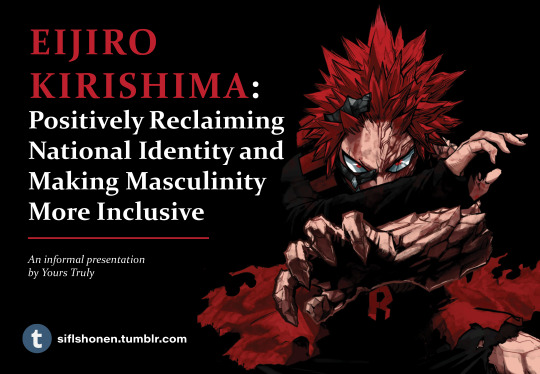
Welcome to the Kirishima presentation 2.0!
What you are about to read combines manga analysis, meta analysis, trope breakdowns, watered-down Japanese history as explained by an outsider Westerner (please take it with a grain of salt), and thematic parallels with other characters. Beware of spoilers up to manga chapter 383.
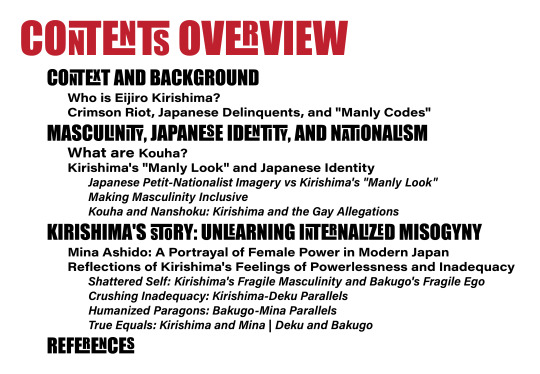
This “presentation” post discusses Eijiro Kirishima’s character and arc as well as the real-life references his character’s aesthetic and “manly” actions and credo are meant to communicate. This post includes a discussion of Japanese delinquents and bosozoku, a brief and simplified history of the relationship of Japanese hypermasculinity and military and naval power, a brief discussion of kouha and nanshoku, and a brief general analysis of how Kirishima's early-series insecurities reflect those of an “emasculated” and outdated Japan in relation to Mina’s “effeminate” Japan of today. It also compares Kirishima and Mina’s history and character growth to Deku and Katsuki. Some of the Wikipedia links are also mildly NSFW, so be careful.
If you take whatever I say about the story personally, or get upset about spoilers that’s on you. On the flip side, if you have something to say on context and history, tell me more! If I offend or misinform in the context of history, please let me know! I have only one perspective, and it is my own.
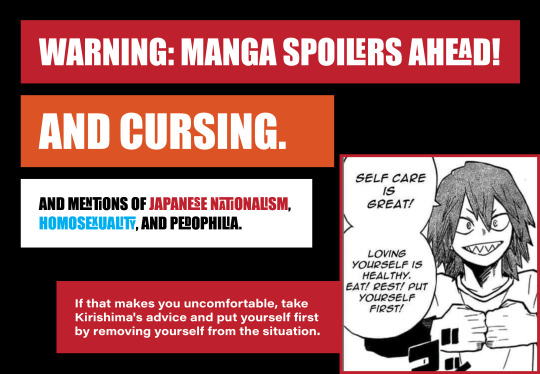
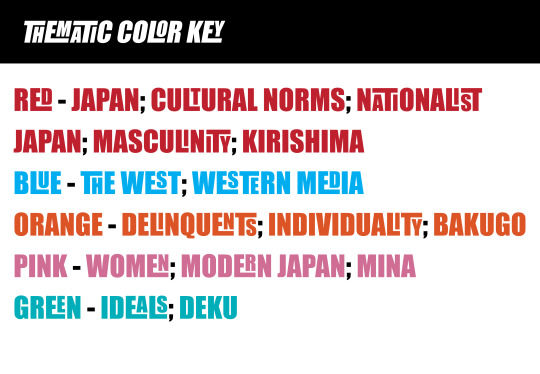
The color key will make sense in time. I promise.
Who Is Eijiro Kirishima?
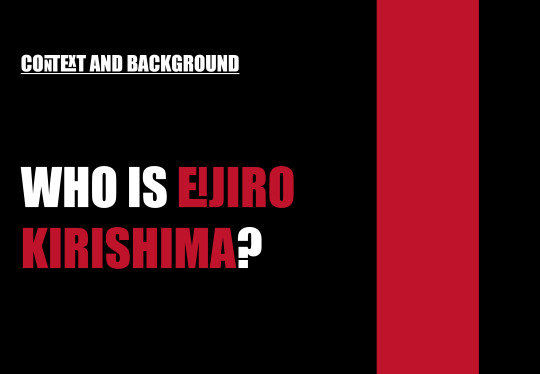

Personally, I love Scorpia. I also love Kirishima. But I do not like it when Kirishima is portrayed to be just like Scorpia in fandom works. Sure, they have similarities (some of which may or may not have been intentionally chosen for Scorpia’s part), but they do not have the same character arcs.
In particular, Kirishima’s arc is very pointedly about his pride and identity as a modern Japanese boy unlearning his internalized toxic masculinity and biases as he grows into a man.
But let’s start with the basics.
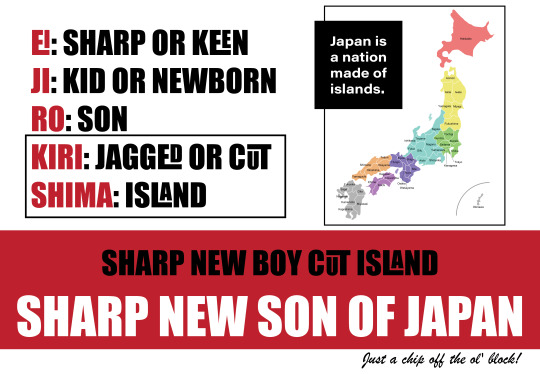
In case Kirishima’s association with his nation of origin wasn’t clear, his name is a dead giveaway.
Ei: sharp or keen
Ji: kid or newborn
Ro: son
Kiri: jagged or to cut
Shima: island
Eijiro means, as this kind person on the internet puts it, “sharp boy”. They also point out that the “Ei” is written in a way not ordinarily associated with names (which is usually “sharp” like “keen” or “intelligent”), so his name subtly “blunts” his intelligence while still pointing (ha) out that he’s a guy made of sharp rocks. And while that’s cute, it’s his last name that gives us more mileage for interpretation.
Kirishima. “Cut island”. Japan is a nation made up of multiple islands.
Kirishima is meant to be, very literally, a fresh-eyed child of his nation. He is emblematic of masculine heritage and identity. That’s a little more nuanced than saying Kirishima is Japan, but he definitely represents a significant pre-World War II slice of it. And he is on a mission to improve himself, and therefore the country, through a new and improved kind of “manliness”. Plus Ultra, bitches.
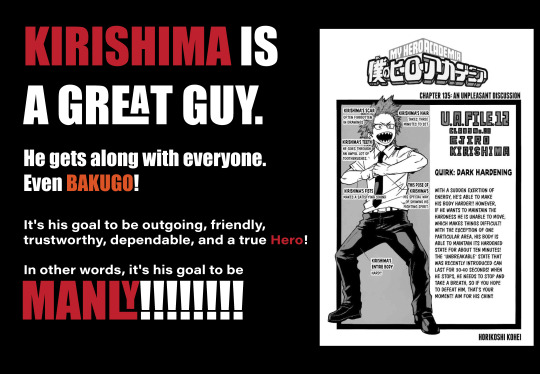
Kirishima is a truly wonderful guy and a unifying factor for the class.
One of the first people Kirishima forms a friendship with is Bakugo. I pointed out some of the similarities between Bakugo’s chosen presentation inspiration and Crimson Riot’s background in the Bakugo presentation. I’ll explore that extensively later on, but just keep in mind that it’s not exactly surprising that Kirishima is one of the first to find a common understanding with the class’ resident foul-mouthed, delinquent, western-style-military-costumed bomb.

One of Kirishima’s most notable qualities is his tendency to describe anything he thinks is positive - the ability to show emotional strength as well as physical, shed tears and show sensitivity, do something competently, show consideration for others, act heroically in a general sense - as “manly”. The gender of the person performing the admirable action is irrelevant.
That last part is a big deal for his character, so I will say it again. The gender of the person performing the admirable action is irrelevant.
Crimson Riot, Japanese Delinquents, and “Manly Codes”
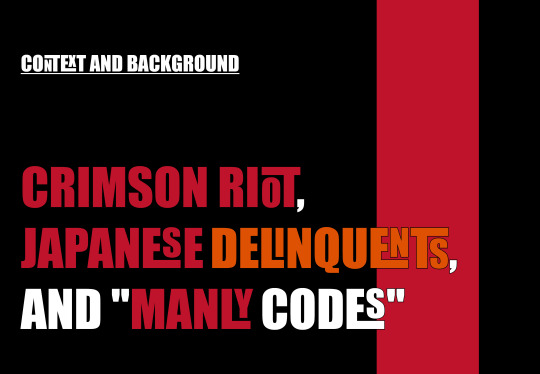

Kirishima’s penchant for calling admirable things “manly” isn’t random - it comes from someone else. His personal hero and role model, Pro Hero Crimson Riot, inspires him to use the language and associate it with positive things not limited or defined by gender. Crimson Riot’s dress, speech, and mannerisms, from which Kirishima also draws inspiration, also tell us a lot about him and his beliefs. Basically, we know he’s a Japanese delinquent/Yankee or bosozoku (which is basically a delinquent on a motorbike.)
Crimson Riot’s “manly” credo is rooted in the values and presentation of this real-world delinquent subculture.
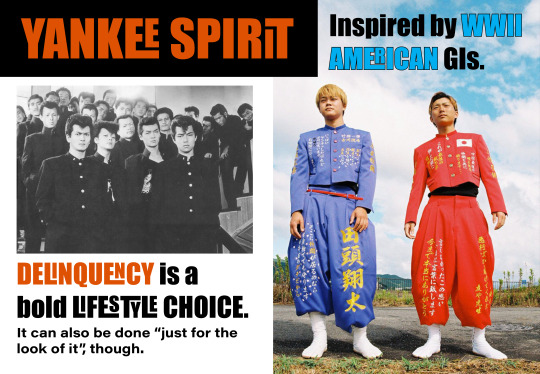
If you read the Bakugo presentation, you’ve seen this slide before.
The term “Yankee” was brought over by US soldiers (if you are from the States, you likely already know that a Yankee is someone from the northeast part of the country) and became synonymous with someone from the United States. Japanese delinquents are called “Yankees” because they walk around like a GI from the United States would - rudely, without consideration for others or the existing culture, and with a seeming need to flaunt their status as foreigners (and, more nastily, “winners” over the Japanese.) I talk more about the origins of the Japanese delinquent subculture in the Bakugo presentation, but the subculture’s origin comes down to this: dissatisfaction with the current society and a desire to express individuality born from something that can best be described as Western envy.
In appearance and attitude, Bakugo is also very obviously a Japanese delinquent boy, though he doesn’t use the same iconography of national pride. For the most part, neither do Crimson Riot or Kirishima. There’s a reason for that.
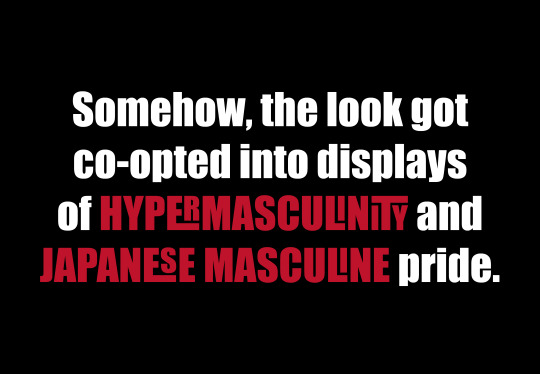

Interestingly, Bakugo lacks these visual markers of the “classic” delinquent look while Kirishima embraces some of them (the color red, the dyed hair with its wild styling, and the modern Japanese flag.) Instead, it seems Bakugo’s chosen delinquent visual identity markers are taken exclusively from the filter of shonen anime delinquents rather than the real world subculture! Their differing attempts to separate the things they like from its historic baggage is fascinating to me, personally.
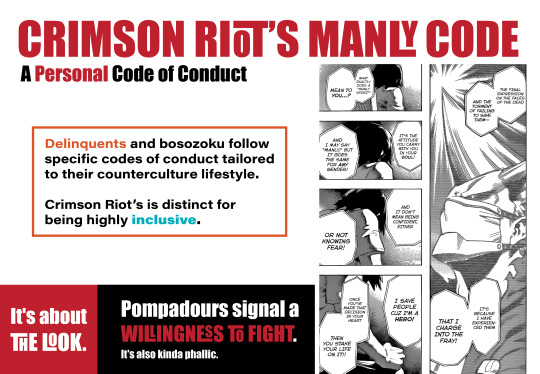
Bakugo’s outlook and personal presentation leans more towards a fictionalized version of the delinquent than Kirishima and his “manly” mentor’s, but the connection between their masculine presentations and implied personal conducts – or the fact that an underlying code of conduct is central to both identities – is still present.
If you read the article on delinquents I linked, you might notice that it emphasizes that a sense of community and closeness is a probable reason for the delinquent subculture’s enduring existence simultaneous to its rebellious and individualistic slant.
Kirishima and Bakugo are good representations of those two seemingly opposite poles, no? Kirishima focuses on creating a sense of community with himself as the unifying factor while Bakugo initially seeks to separate himself through his individuality.
The Yakuza framing of chivalry is not exactly the same as bushido, but rather the idea of “acting chivalrously” through what they refer to as ninkyodo, or the “way of humanity.” There’s still influence from and elements of bushido in this, however.
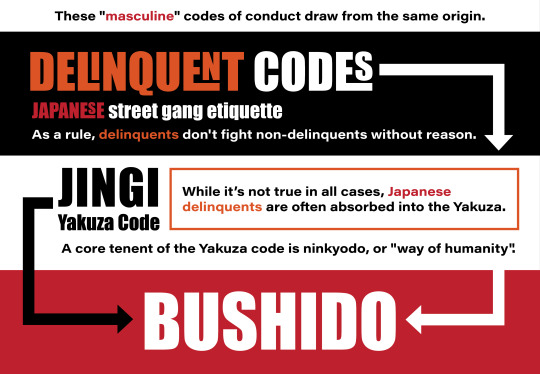
If you’re reading this, you’re probably a weeb, so you have likely heard of Way of the Househusband/Goshufukudo. The series’ tagline, “housework without honor or humanity!” is a play on the main character’s status as an ex-Yakuza because he left the Yakuza - or strayed from his ninkyodo/path of humanity - to be a househusband. It’s also a play on the Battles Without Honor or Humanity movies revolving around the same sentiment – except without the househusbandry part, of course.
(Also, the Yakuza created a recruitment website called ninkyodo. Considering the bigger discussion of social unrest and subdued envelope-pushing inherent in this manga, this wacky little blog post is worth a look since it pivots around the Japanese mob being upset with the government’s social programs.)
Delinquent codes draw from the Jingi, or Yakuza code and ninkyodo, which draws from bushido. You know what else draws from bushido? Most forms of contemporary and historic Japanese government.

Bushido has seven core values: gi (justice), yu (courage), jin (benevolence or another word for humanity - and yes, this is the same character as the “Jin” in Twice’s given name, Jin Bubaigawara), rei (gratitude - and no, this is not the same character as Rei Todoroki’s given name but it sounds the same), makoto (sincerity), meiyo (honor), and chugi (loyalty).
Why is this important? Because there is one VERY big difference between Kirishima’s presentation and aesthetic and that of Crimson Riot and Bakugo’s, and it also involves bushido and its masculine, militaristic associations.
In addition to Crimson Riot and delinquent culture, Kirishima blatantly includes kouha as one of his inspirations. Bakugo does not, and it is unclear if Crimson Riot pays attention to them specifically.
What Are Kouha?
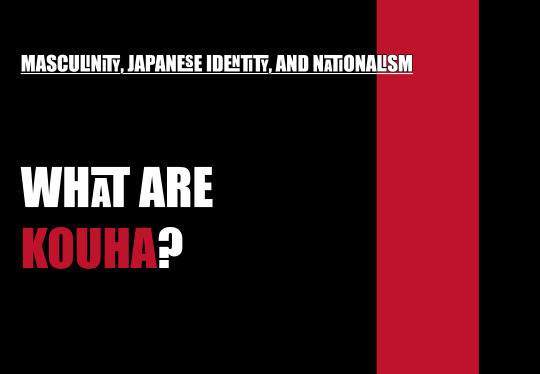

Kouha are, as Kirishima’s middle school classmates might say, “old school”. They’re even more old school than delinquents (or Crimson Riot), and they are also deeply nationalist. Kouha were a cultural phenomenon born from the student populations of Japanese military schools (the establishment of the Japanese Imperial Army is considered the first formal step of Japan’s westernization, by the way!) during the Meiji era. They held specific beliefs about male supremacy, masculinity, and national pride. To kouha, these concepts were inseparable from one another. They, and their resulting legacy as soldiers and Navy members in subsequent wars, are the main reason that quasi-nationalist or outright nationalist symbolism is so thoroughly entrenched in Japanese presentations of hypermasculinity even in the modern day.
Basically, kouha = Japanese Nationalists. This is an simplification, but you can read this entire Wikipedia article if you want a better picture of what I mean or need a starting point for your own research.
But don’t freak out! Kirishima’s admiration of kouha is, mostly, for the sake of a pun.
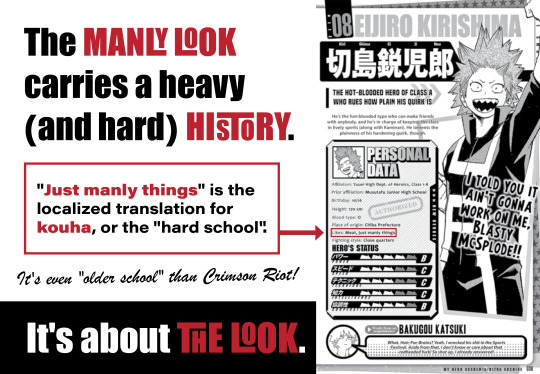
Horikoshi lists one of Kirishima’s favorite things as kouha (called “manly men” or “just manly things” in the most commonly circulated English versions), which means, more or less, “hard school”. It’s a pun on Kirishima’s hardening quirk. However, it also refers to Kirishima’s penchant for historically manly things and hypermasculine presentation.
Kirishima’s “Manly Look” and Japanese Identity
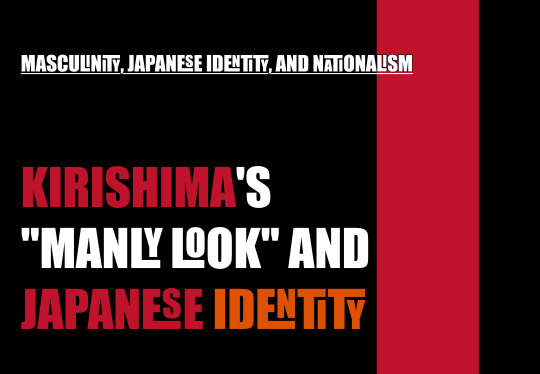
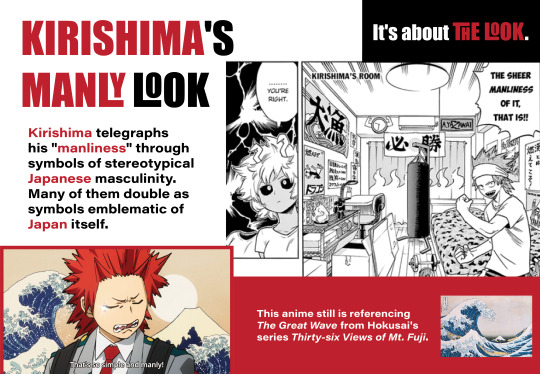
So, to review: Kirishima’s Crimson Riot-inspired philosophy and aesthetic is drawn from delinquent culture, which is a subculture that takes its cues from bushido – literally “warrior way” but sometimes called “samurai code” in English – which is in turn associated with Japanese pride and even nationalism. This association is very clear in Kirishima’s aesthetic. Look at his room. The Mount Fuji and ocean wave iconography, his hachimaki (admittedly this is relatively common among modern Japanese students, but it still carries a history), the tacky flames in representation of a “burning soul”…
But you know what he doesn’t use? Red sunbeams. This is really important.

The specific “tackiness” and “kouha look” Kirishima enjoys can definitely be indicative of outright nationalism, but it is also associated with other hypermasculine subcultures that are not necessarily nationalists, including delinquent subcultures (though modern ones don’t often use the sunbeam-laden rising sun flag anymore. Modern delinquents usually stick to the modern Japanese flag as part of their uniforms or flags)
The fact that Kirishima’s “kouha look” does not include the sunbeam-laden Rising Sun flag (which, from the perspective of non-Japanese, is associated internationally with war crimes and, for related reasons, the Japanese Navy. Consider it a Japanese swastika—not to be confused with the Japanese manji, which is actually a totally different thing) or red sunbeam motif. This could be because My Hero Academia is set 200 years in the future and the rising sun imagery has fallen out of public memory. But personally, I think it is more likely that Horikoshi (and therefore Kirishima) wants to signal that Kirishima doesn’t hold the same beliefs as kouha and Japanese nationalists.
Even so, Kirishima’s “look” still suggests kouha and still associates his masculinity with his national identity.

This isn’t a perfect one-to-one localization, but, for us in the West, we can sort of think of it like this: the difference between Kirishima and a neo-nationalist is not unlike the difference between guys who authentically really like Viking iconography and neo-Nazis who appropriate Nordic iconography for their beliefs. It’s just that Kirishima seems to be reclaiming these symbols in reverse. (It’s probably a really good thing Mina knows Kirishima from his time before UA, or else she might have given him a way more intense and judgemental side-eye over what’s in his room.)

I suppose if one really wanted to, one could use everything I’ve written as an argument to say, “If you like Kirishima, you fell for the Japanese militarism and neo-nationalism apologist ploy”, but I don’t think portraying him as an apologist was the intent. I choose to see this as a shonen comic about superheroes and connecting the past with the present in pursuit of a better future because that’s all I think it is trying to be.

Again: Kirishima and Crimson Riot’s “manliness” philosophy departs from that of the kouha, Japanese nationalists (and neo-nationalists) because it is inclusive. The use of elements of their aesthetic preserves Kirishima’s personal pride as a Japanese guy - specifically as a “masculine” man - while his take on “manliness” is modern and geared towards celebrating the intrinsic goodness of humanity that isn’t defined by gender, sex, skin color, or even nationality, really, except as it applies as it being a thing for each individual to celebrate about themselves.
There’s other stuff kouha did and didn’t do that Kirishima doesn’t seem concerned about, either.

As I’ve said, modern Japanese sociopolitical (and masculine) identity is strongly associated with bushido. Bushido and kouha, particularly during the Meiji era and Russo-Japanese war (y’all ever read or watched Golden Kamuy?), is consequently associated with the Japanese Navy and nanshoku (THIS WIKIPEDIA ARTICLE IS MILDLY NSFW), or the practice of male-male relationships ranging from ritual pederasty to what one could interpret as “just plain gay” by modern western standards.
Whenever the Eastern or Western fandom discusses the possibility of Kirishima being gay-coded, this association between his kouha aesthetic and nanshoku is almost always at the heart of it. Well, that, and Kirishima’s dogged telegraphing of how much he’s into the kouha aesthetic and other “manly” things. To the modern Japanese, a high degree of overblown hypermasculine presentation and speech can come across as performative overcompensating.
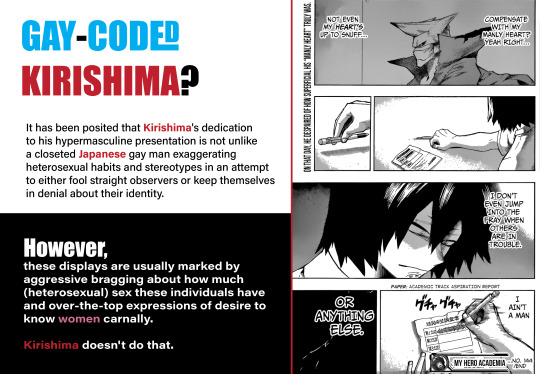
However, there’s one big detail that’s usually missing from these discussions in fandom: generally, the display of hyper-masculinity that is associated with performative overcompensating from closeted gay men includes constantly talking about how much heterosexual intercourse they have (which, according to them, is a whole lot) and how much they love women. Carnally. Sometimes they may even hit on women to an absurd and almost cartoonish degree – but usually only performatively in front of others or to try and fool (or repulse) the woman on the receiving end! The goal of a closeted gay person telegraphing heterosexual stereotypes to such an extreme degree is to either:
1. fool other people into thinking that they are not gay (which is often not very successful)
or
2. Keep themselves in denial by playing the part of an ultra-straight dude.
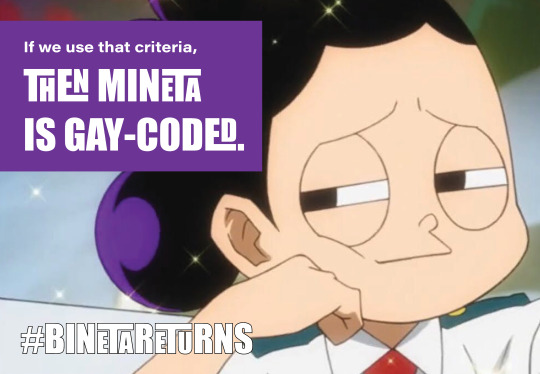
So, if I am using hypersexualized hetero behavior as the main parameter for how gay-coded a character is, I could argue that Mineta is more gay-coded than Kirishima is. He’s not, but I could make the argument.
But why would a gay person feel the need to do either of these things? Oof. Ain’t that the question. Masculine fragility has different nuances between cultures, but it isn’t exclusive to English-speaking countries. Modern Japan (read: Meiji era to post-World War II Japan that did its damnedest to Westernize as rapidly as possible) is relatively homophobic and views homosexuality as, well, “unmanly”. You can read more about that in the kouha and nanshoku Wikipedia articles I’ve linked. That’s the power of comphet!
That said, I don’t think Kirishima is gay-coded based on his affinity for manly stuff. He’s not using it to compensate for his sexuality. If anything, at his lowest, he used his “kouha-manly” presentation to compensate for his self-perceived lack of heroic and “manly” spirit. True heroism is what defines Kirishima and Crimson Riot’s perception of “manliness”, not sexuality. In fact, that’s the core of why their ideology is so progressive and why it flies in the face of its kouha-presenting packaging.
I mean, Kirishima could have any sexuality out there, but I don’t think his “kouha-manly” look is meant to be indicative of it, whatever it is.

Mina Ashido: A Portrayal of Power in Modern Japan
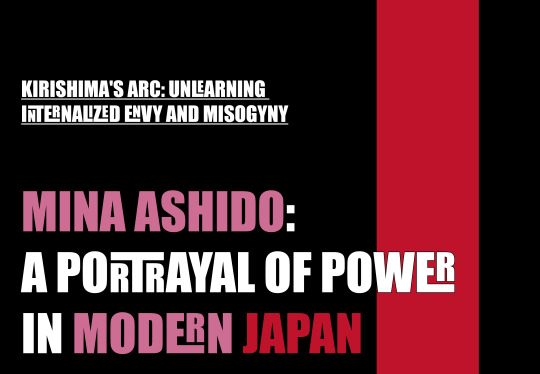
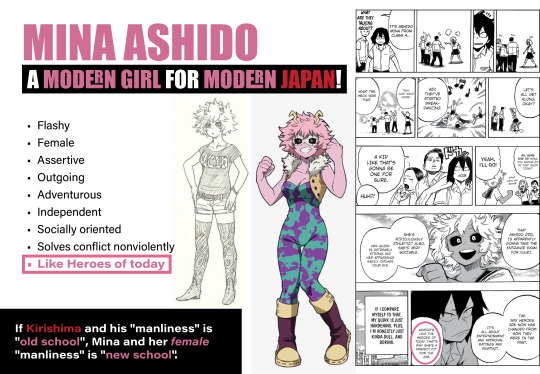
Mina is a major foil to Kirishima, so this writeup would be incomplete if I didn’t talk about her. If Kirishima is the “manly” Japan of a bygone era questioning how he can be relevant, Mina is “effeminate” modern-day, westernized Japan. Also, Kirishima’s key color is red. Hot damn, that’s flashy! It’s also the color of the sun on the Japanese flag! How fitting that Mina is represented by pink, or “light red”.
Simplifying the characters of Mina and Kirishima primarily by gender categories like that is a little more charged than I would prefer, but let me explain my logic.
During Japan’s occupation by the Allies after World War II, women gained, among other things, the right to vote. To quote Wikipedia directly: “It has been argued that the granting of rights to women played an important role in the radical shift Japan underwent from a war nation to a democratized and demilitarized country.”
They also were no longer bound exclusively to the home as wives and mothers, but could also take employment. Got it? Good. While I needed to explain this to set the stage for the stark difference in gender politics between the kouha’s heyday and womens’ standing after World War II, this is only loosely related to Mina and her portrayal.
Much like Kirishima, the biggest tells are evident in Mina’s look. In simple terms, traditional Japanese femininity isn’t flashy, isn’t westernized, and women don’t take the lead. Mina is flashy, westernized, and she does lead. In the manga, this is framed as a positive by her peers and something Kirishima admires and envies. (I have no idea how the older generation feels about it. We don’t know much about Mina’s personal life, unfortunately.)
Mina is a very modern girl. She stands out because of her natural appearance, but she also dresses ostentatiously whenever she isn’t wearing her high school uniform. Her look favors an updated spin on the gyaru subculture. In fact, while part of her natural appearance rather than intentional choice, I could argue that Mina’s startlingly black eyes and “unusual” skin is meant to indicate the yamanba (spinoff from ganguro) fashion subculture, but I’m not sure I am meant to go that far. Regardless of the specifics, everything about her appearance implies the largest commonality between most modern young Japanese women and every female-specific fashion subcultures (including lolita or kogal – Toga is a kogal): rejection of traditional gender roles and presentation.
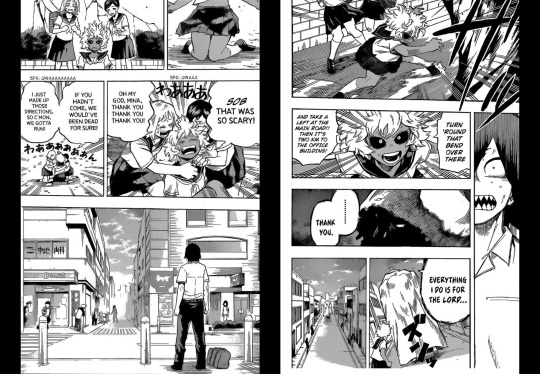
I’m gonna sum up Kirishima’s own personal plot and backstory for the sake of reference.
Kirishima is a guy with a hardening quirk. It’s not flashy or particularly suited for offense or rescue, and he’s self-conscious about how “worthy” he is to be a hero not just because of his lackluster power, but because, in the past, he’s avoided stepping in situations where, if he were a true Hero, he would have stepped in and offered support without thinking about it!
Sound familiar?
Instead, his childhood friend (that he secretly admires very much but also feels very insecure around) stepped in to be capital-H heroic while he stood and gaped uselessly! And what’s worse? She is a GIRL. A WESTERNIZED GIRL did what he couldn’t do. So, obviously, if he can’t be more heroic and “manly” than a GIRL, he isn’t manly at all. And he’s scared of that.
Sound familiar?!
In high school, Kirishima puts on an outgoing persona (complete with a new hairstyle) inspired by his childhood hero (and also, lowkey, the childhood friend with which he associates the same kind of true heroism) to cover for his insecurities!
SOUND FAMILIAR?!
But that’s enough about how Kirishima and Mina’s story parallels Bakugo and Deku’s for now. Allow me to throw the other parallel in your face - the one between Mina and Kirishima and Japan and the US’s policy changes after WWII.

Mina, the modern, westernized Japanese girl, was first to act when “foreign power with old loyalty” Gigantomachia threatened their classmates. She solved the confrontation – and solved other confrontations with her peers – nonviolently. Meanwhile, kouha-aligned (militaristic and masculine Japan) Kirishima was not only unable to act (aka did not have any military influence), but felt completely useless and superfluous in both of these instances. (But later, when Gigantomachia re-emerges in a context that Mina cannot possibly solve on civil terms or with misdirection, Kirishima is able to defend her and do what she can’t. Even later, Mina learns the best ways to kick someone’s ass with her acid. She acts as the sword - or perhaps more precisely, the spear - to Kirishima’s shield.
If you didn’t know, the “sword and shield” analogy, or more commonly, “spear and shield” analogy is, or, at least, was, used to describe the US and Japan’s relationship after WWII. Whenever Kirishima talks about being the “ultimate shield” or “ultimate spear”, this means something.)
So, yes. This story is about the modern and traditional; the feminine and the masculine; the West and East. Just like Bakugo and Deku.
There exists a complicated relationship between national shame over losing the war, shame from Japan’s own war crimes, shame in Japan’s continued political ineffectiveness without a strong established military, and outright Japanese envy of the West for not only winning the war but epitomizing prosperity and modernity (or appearing to do so, at least.) I really don’t have the background to talk about this in-depth or respectfully. The point is that overt pride in the Japanese identity is a complicated issue, but particularly as it reflects in expressed Japanese masculinity. For Kirishima, his early relationship with Mina and the envy he feels towards her is a succinct crystallization of these feelings in allegory form.
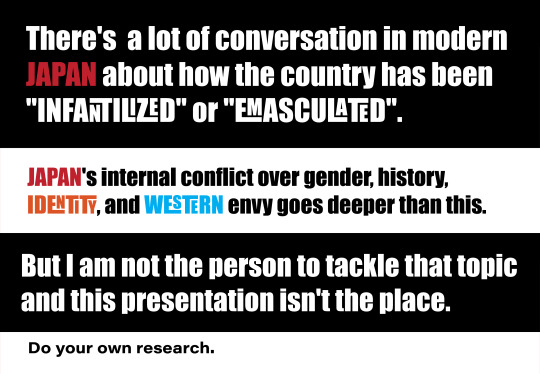
In the Bakugo presentation, I mentioned that the shonen genre was “born” after World War II and the art form still incorporates postwar baggage. This includes the aftermath of the nation reeling from its lack of military power after the war. I’ve already drawn a clear line between Japanese military might and its masculinity, so I don’t feel I need to elaborate much about why I make this next statement: a significant swath of the Japanese felt the loss of military power emasculated the country (which, as discussed through Mina, made it “effeminate”. Or, depending on the perspective, it “infantilized” the country. This introductory course examining shojo manga and identity touches on the infantilization of Japan through media exports and branding if you’d like to read another perspective using this terminology.)
I feel I should mention that Japan’s current crisis regarding declining birth rates is often associated with the lack of “properly masculine” men and the growing ability of modern Japanese women to put off or refuse marriage.The first observational piece about male subgroups discusses how masculine identity and neo-nationalism seem to be closely associated or even conflated for one another by the individuals in the neo-nationalist subgroup, but also alludes to the fact that a lack of clearly defined masculinity is being treated as a national crisis since it is seen as a prohibitive factor for Japan’s current generation to start families. To that end, Prime Minister Shinso Abe pushed for a variety of measures to encourage people to have kids.
In fact, Shinso Abe has achieved meme status in international otaku circles because whenever an anime or manga encourages or portrays sex for the purpose of procreation and raising a family as expected and singularly correct, the community wonders if it’s anime propaganda aimed at encouraging Japanese viewers to go have kids. This, combined with the fact that Shueisha/Shonen Jump upholds certain beliefs and gender/sexuality power dynamics in their company policy that is reflected in their published titles, will be important later in this series of presentations. For now, it’s just something to think about.
In shonen manga, including this one, the focus on men/growing mens’ identity (and the Japanese-specific flavor of masculinity) in a modern and changing world comes up a lot. While not directly related to Kirishima’s chosen counterculture influences, here’s a link to download an observational piece describing three notable cishet male Japanese subgroups struggling to define (or redefine) their own masculinity and identity: herbivorous men (kind of like western hipster metrosexuals), otaku (you know what these are), and Japanese petit-nationalists (basically neo-nationalists. And yes, they share elements from Kirishima’s aesthetic. If this were about Spinner and any heteromorph characters, this particular group would be much more relevant to this discussion.) Here’s another piece focused on “genderless” danshi and masculinity. Both of these pieces discuss the precarious correlation between male identity, community, presentation, and values. That, and I think they’re neat topics – though I do suggest you think critically about what you read in them.
Anyway, let’s get back to talking about this damn manga.
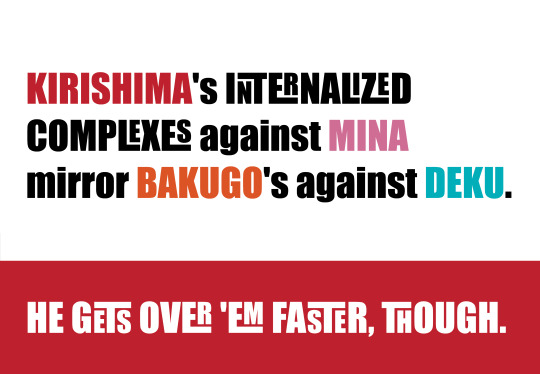
If you ever asked yourself, “How would Bakugo and Deku’s relationship differ if Deku had a quirk?” or, “How would Bakugo and Deku’s relationship differ if one of them was a girl?”, here’s your answer: it would be very similar to the relationship between Kirishima and Mina. Most of the relationships between pairs or sets of characters is meant to reflect off of the relationship between Bakugo and Deku in some way as either a compare/contrast exercise or to show how different things could be if fate had conspired to make one or two small differences in their lives.
This is thematically crucial to understand for almost every moment in the story.
Reflections of Kirishima’s Feelings of Inadequacy and Powerlessness
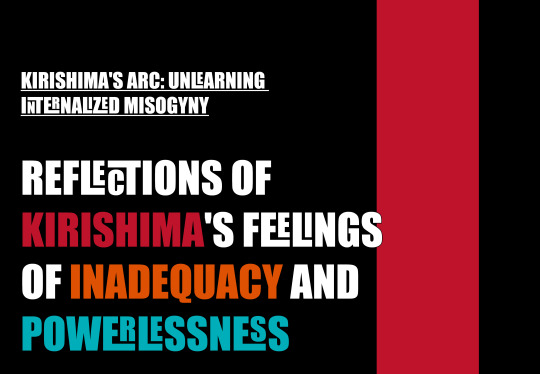

Kirishima and Bakugo have a lot in common. It’s not terribly surprising they became friends even when Bakugo was at his worst, since Kirishima could likely relate to where he was coming from and how he was feeling on some level.
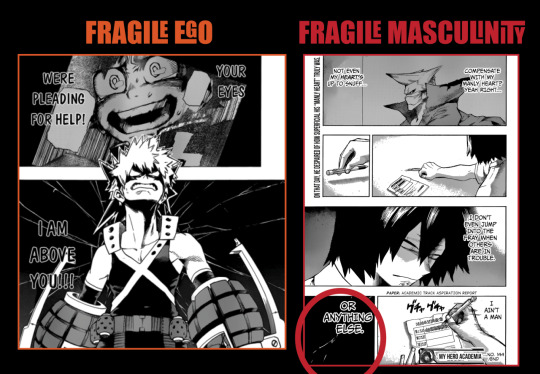
If you thought Mina being a girl was inconsequential to Kirishima’s feelings of inadequacy, think again. Luckily for everyone, Kirishima isn’t as much of a sensitive, fragile, and dramatic bitch as Bakugo about his insecurities.
Kirishima also hadn’t been explicitly stewing on them as they applied to one specific person for roughly 11 years of his life, either, so. There’s that.

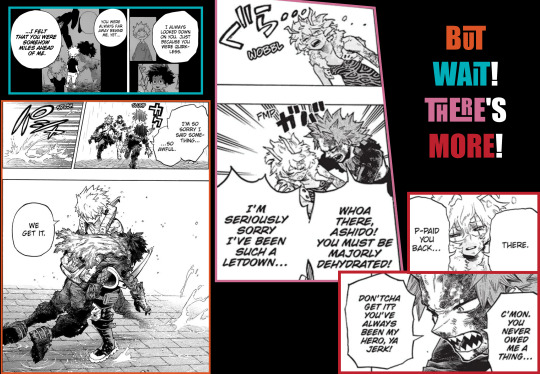
Bakugo’s relationship with Kirishima is an introductory course for him on how to have a positive relationship with Deku. For Kirishima, Bakugo is a proxy for relating to and helping the person in his life that he admires most: Mina.
But the Kirishima-Bakugo parallel isn’t the only parallel we need to draw.
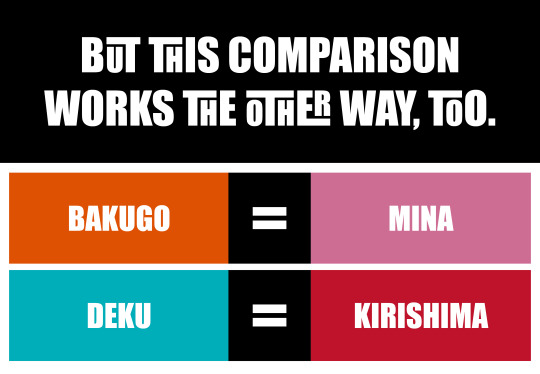
Arguably, Kirishima shares more similarities with Deku than Bakugo (but, of course, Deku and Bakugo are also very similar, too.) Kirishima is not confident in himself, mimics his idol very closely, is very concerned with upholding the status quo (through interpersonal harmony), got into UA through his effort rather than because he has a well-suited quirk, is quick to act “heroically” and put others before himself, is quick to throw himself into danger on others’ behalf (he’s got a hardening quirk, so unlike Deku he doesn’t mangle himself repeatedly with these stunts), and has an I-won’t-admit-it-for-most-of-the-series-but-I-will-broadcast-it-in-other-ways object of admiration in his childhood friend Mina.
Also, Kirishima feels woefully inadequate when compared to Mina because, in his eyes, she already has the appearance of a hero (and professional Hero.)

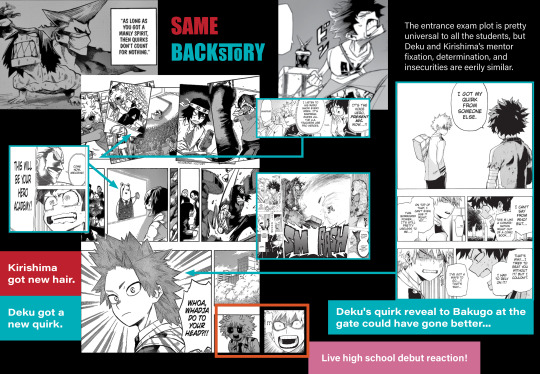
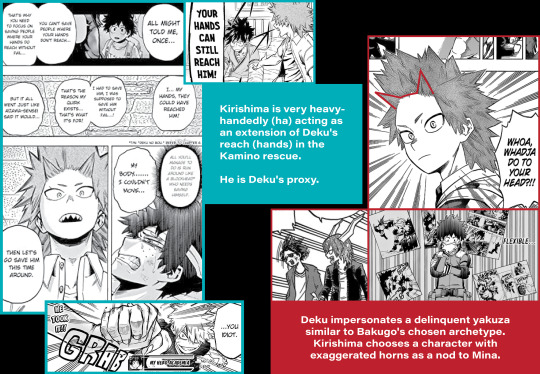
Kirishima’s outgoing attitude is a product of him pushing himself to be more like Mina in charisma and approachability. The horns of his hair are also inspired by her, too. While both of these things can be framed as parallels to Bakugo’s admiration of Deku as I did earlier, they are more on-the-nose for Deku’s penchant for intentionally talking like Bakugo when he wants to psyche himself out and copying all of Bakugo’s moves in order to best harness his quirk. And, of course, when Kirishima and Deku don disguises to go save Bakugo, they choose outfits with exaggerated horns (like Mina) and a Yakuza/delinquent persona (like Bakugo) respectively.

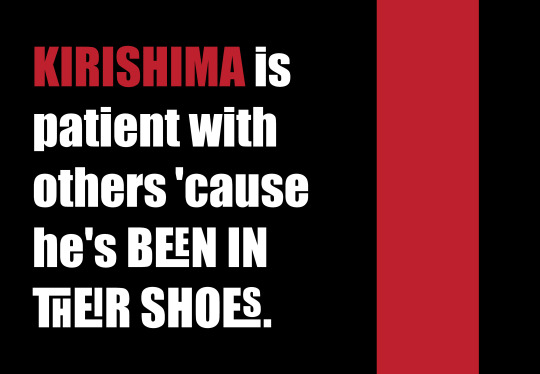
Kirishima seems to be able to “read the room” when it comes to the relationship between Deku and Bakugo - and in both directions. Personally, I am not surprised that he chooses to quietly support both of them when it comes to the other.
But perhaps the more interesting parallel is the one drawn between Bakugo and Mina.
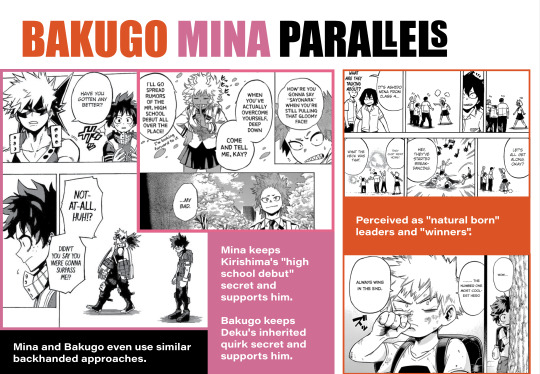
When Mina uncovers Kirishima’s “secret” (he dyed his hair and changed his outward persona to make a good impression as a friendly and outgoing guy with his “high school debut” rather than come off as a shy fanboy), it’s analogous to Deku telling (albeit vaguely) Bakugo about One for All at the beginning of the manga. Both scenes even take place at the start of the school year with cherry blossoms in the background and stuff. Later in the series, after Bakugo figures out the full secret of OfA (much like Mina figures out that Kirishima wants to be popular), he even explicitly says he’ll keep Deku’s secret.
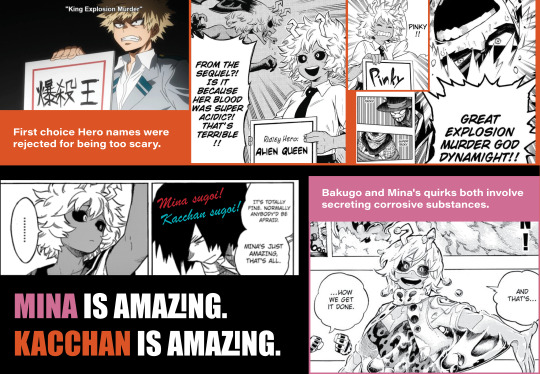
Mina and Bakugo are both described as “amazing” and both imply significant discomfort over the generalized compliment. It’s a huge expectation to carry.
Mina’s “Alien Queen” is denied as a Hero name just as Bakugo’s “King Explosion Murder”. Huh. Funny, that.

Kirishima and Mina are constantly improving using the other as inspiration, just as Deku and Bakugo do. They learn from other sources, too, of course, but these two sets of characters have an established feedback loop.
While Bakugo doesn’t struggle academically like Mina, especially during the training camp, his personal failures, many of which are social, are often broadcast on television. Both of them look like idiots in front of their respective foils.
Also, Bakugo and Mina both kicked ass at the school festival - Mina with the dancing and Bakugo on the drums. Deku and Kirishima were, you know, support. Extras.
During the festival, Mina and Bakugo were also both demanding taskmasters - Mina expected the best of her dance crew while Bakugo always had something to say about the pace and technique of his band members. Ha!
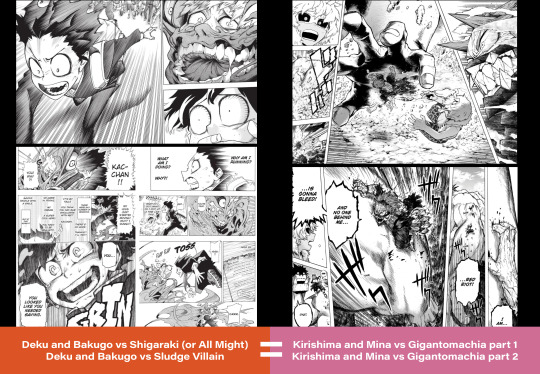
When Kirishima saves Mina in their confrontation with Gigantomachia, he does it without regard for his own safety (after initially hesitating and panicking like Deku did for the first part of the sludge villain incident!) Gigantomachia is also, interestingly, a shared past foe of Kirishima and Mina much like the sludge villain is for Bakugo and Deku.

Considering how they parallel one another and how Mina’s Acidman Alma is inspired by Todoroki and Bakugo, I like to think that her win against the sludge villain was an inadvertent moment of revenge on Bakugo’s behalf, even if her character didn’t intend for it to be.
Chapter 383′s initial fan title translation of “A Small Heart” is also interesting, considering how the turn of phrase relates to the figures of speech used for Bakugo’s ego in the manga’s early chapters (inflated heart.) Viz translated it as “Meek Spirits”. A “small heart” seems to indicate cowardice or fear on Mina’s part (or the Sludge villain’s.) Despite Bakugo’s inflated ego (heart), his was also rather small in terms of facing his secret fears of inadequacy and, well, Deku.
The point is, even when Mina and Bakugo’s hearts were “small”, they saved Kirishima and Deku respectively.
Someone who knows more about Japanese could say more on this, as well as share more disambiguation between whether the English or Japanese connotations of the word “heart” are at play here. There’s some discussion about that in the Uraraka-Bakugo-Toga presentation.
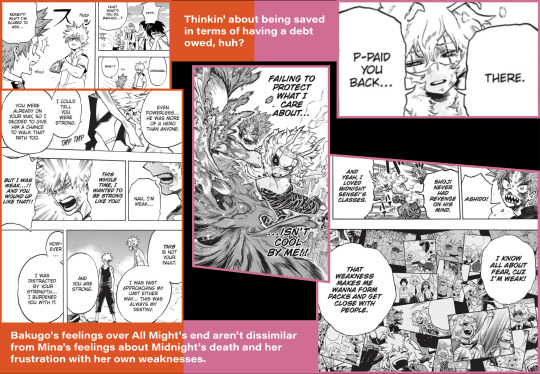
For all her confidence, Mina gets scared and nervous, too. But she doesn’t give up!
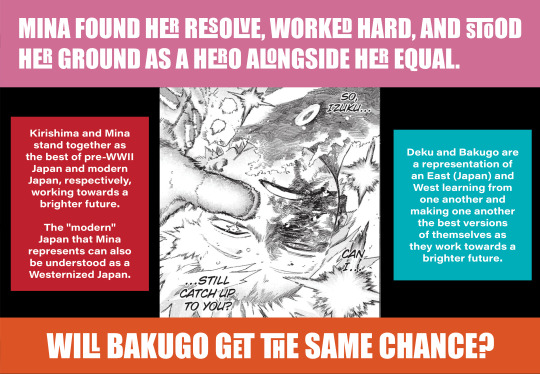

Mina gets it done!
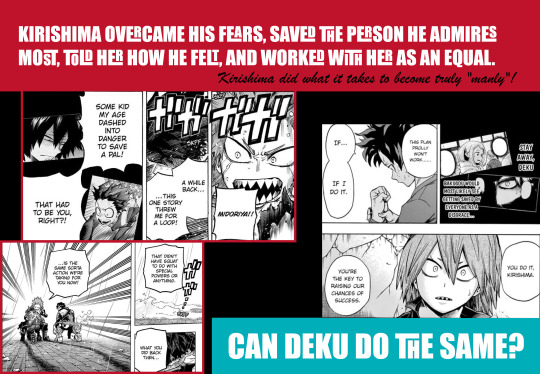
Will Bakugo and Deku accomplish what Mina and Kirishima have? I dunno. But even so,

Kirishima rocks on his own and alongside Mina!
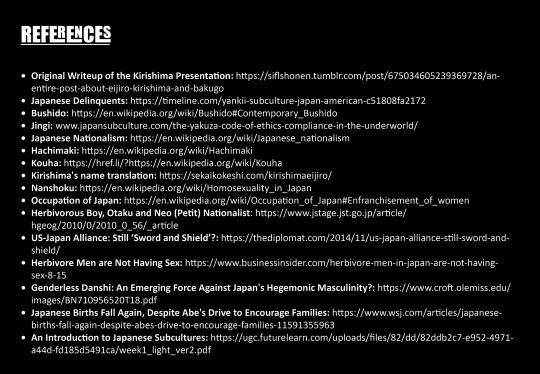
#bnha#bnha meta#bnha manga spoilers#kirishima eijiro#mina ashido#kirimina#bakugo katsuki#izuku midoriya#bakudeku#kiribaku#mha meta#mha spoilers#my hero academia#kirishima presentation
234 notes
·
View notes
Text
It Should Have Been Jonathan: Why Swapping Jonathan and Mina's Roles for the Blood Ceremony Makes Dracula a Better Story Both Thematically and Plotwise
Bram Stoker did not write it this way, so swapping Jonathan in is not a headcanon, but rather an adaptational choice that adaptations like Murray Mysteries or fic writers (like me!) choose to make over and over again. Here's why you should engage with this premise.
(No spoilers for those caught up to October 3rd of Dracula Daily)
(non-graphic mention of rape, sexual assault, etc)
The Story As It Is: The Good Points
Jonathan um. Goes Through it this novel. If you hadn't noticed. Mina takes care of him a lot, and after the blood ceremony, Jonathan gets to take care of her. This is very sweet, and I do enjoy that both Mina and Jonathan take turns rather than Jonathan always needing help.
It's not like it's unrealistic. Dracula would totally retaliate against the men fighting against him by targeting Mina. He super would see this as very apt revenge, and he's definitely that brand of sexist that sees women as a prize.
This plot point goes out of its way to frame the actions of the men in excluding Mina as utterly disastrous, which is cool.
Mina as the Victim: What is it Accomplishing + How Did She Get There
Mina spends most of the novel taking care of the people Dracula's victimized. She is a force to be reckoned with, but as Stoker wrote her she is a very good sort of English woman, pious, obedient to the men, respectable, etc. etc. Although she and Lucy have very different characters, when Dracula targets them they serve the same role as good English women who are coming under attack by Dracula, an evil Eastern European man. In Lucy's case he literally kills her and in her place is a hot sexually impure corruption of the original person. Victorian nightmare fuel. In addition, there are all kinds of sexual non-con rape vibes to what he does to both Lucy and Mina. Hot forceful foreign men are invading England and targeting good women. That's the whole fear that Dracula represents.
This manifestation of xenophobia doesn't hold up at all. For me, it's always been the worst element of the novel. I don't find it compelling.
Something else you might have picked up from this update: martyr talk martyr talk martyr talk. While (trust me) Mina is still smart and still given a lot of agency by Stoker to break her own curse, after the blood ceremony, she suffers Very Piously. Like a hair's breadth away from publishing a video entitled "How To Suffer A Tormentor From Hell in A God Honoring Way" on her Youtube Channel.
I personally don't find this interesting. I don't think it holds up. I don't want to see Mina suffer like a Perfect Little Christian. I want to see her kick ass and take names.
In conclusion: the driving forces behind Mina's attack and trauma are at best uninspired and outdated, and there is a very nasty undercurrent of xenophobia and sexism there as well.
I don't love it. I'm either bored or actively turned off by what Stoker is trying to say.
Jonathan as the Victim: What Could It Accomplish?
Dracula choosing to attack Jonathan again would shift the narrative so that it becomes a story about an abuser who will Not Let Go. An abuser who follows across a continent. An abuser who waits until you've just started to recover from the first round of trauma and started to feel safe again to start an onslaught even more vicious and concerted than the last.
I think Stoker laid the groundwork for this twist to be more terrifying and compelling than for Mina to be targeted 2/3rds of the way through. Obviously Dracula is an abuser no matter what, but it so much more terrifying to me to think of him playing a long-term game of cat and mouse over like 6 months with one man, than it is to see him target Mina over the span of three days.
This is also in character for Dracula. I agree with the common interpretation that Dracula continued to target Lucy even when it got ridiculously difficult and dangerous to continue because he can't stand to lose a test of dominance.
If we carry that over to Jonathan there is absolutely no way that Dracula would be ok with learning Jonathan escaped and is recovering. He would Hate that. He would absolutely want to target Jonathan again.
So you remember "I too can love" "tonight is mine" the gaps in the journal? All that abuse that is hinted at and never explored? The same sort of sexual assault motifs that are so present in Lucy and Mina's attacks? The implication that Jonathan was fed on by Dracula? All these hints that Stoker doesn't do anything with or develop further? Well Making Jonathan the one who undergoes the blood ceremony gives us a very natural chance to discuss them again.
In conclusion: Jonathan's history with the Count makes him being the victim (again) a more compelling story. We've watched the Count slowly escalate aggression with him over the course of a novel, and this final attempt to literally claim Jonathan's soul and make him a thrall is the natural conclusion of that. To me those are some compelling stakes
Jonathan being Targeting Makes for Less Plotholes (and less Infuriatingly Sexist Plotpoints)
Not that Mina being excluded is unrealistic or unworthy of engaging with in the original novel but I find it to be such a drag
And actually to a certain point it is unrealistic to me because I think the decision to completely cut her off and stop talking to her about anything comes completely out of left field. Everyone was acting like she'd work with them in some capacity right up until Van Helsing says differently. I find that jarring.
Switching the target to Jonathan eliminates that plotpoint entirely, which I think is cool. Maybe Stoker never would have written Mina as one of the boys, but it's not the 19th century anymore and we can write Mina however we want. I think having a Mina that sticks up for herself and refuses to be excluded is neat.
But on what grounds would they choose to exclude Jonathan? Well I actually think that some obvious solutions present themselves.
Murray Mysteries goes the "Jonathan you have PTSD you shouldn't retraumatize yourself route" which works for them, since it's a 21st century retelling
But I actually think it could potentially make sense for Van Helsing to want to exclude Jonathan, and to need to be secretive about it.
So you know how in the canon Dracula gives Mina his blood partially because his intention was to make himself a spy? The plan was to use an unwitting Mina to his advantage but the polycule bursting in killed that idea.
Well if I were Van Helsing, I would immediately suspect that the Count had fucked with Jonathan at the castle. I mean it would make so much sense wouldn't it? Jonathan was there for two months, he could be compromised in so many different ways.
If Van Helsing had these suspicions, then it would be the natural next step to try and exclude Jonathan from the business as completely and utterly as possible under whatever flimsy excuses he can make up (and this man has been making up flimsy excuses for the whole novel so it's in character).
This adaptational change would lead into Jonathan getting attacked again very smoothly, except in this version, Van Helsing's reasoning has more grounds to it than just Sexism, so he would be not only a smarter character, but also one I'd want to punch less.
I think that makes for a stronger plot
Also it seems very natural to me that Jonathan wouldn't realize he'd been attacked again by Dracula. More natural than Mina not realizing. This man has been having PTSD nightmares and flashbacks about Count Dracula attacking him for the entire summer and early fall. Canonically his trauma made it difficult for him to separate dreams from reality in the past. He would just assume they were particularly nasty dreams.
This would also apply to Mina not noticing Jonathan was being fed on as well. She's used to him not looking well and having bad nights. It would not immediately be apparent to her that this was different that the usual.
In conclusion: Jonathan being the one who is attacked opens the door to other obvious plot changes that create a better story structurally.
Okay You've Convinced Me, I Want to Explore This
Listen to Murray Mysteries! Listen to Murray Mysteries if I haven't convinced you, it's really good and it's the only adaptation I know of that actually adapts the Polycule in a good way.
Read my series! I don't mean to self-promote but if you couldn't tell I feel incredibly strongly about this premise and I don't see people tapping into the potential so I've had to do it myself. Strange Wonders is a series of short stories that explore the plot of Dracula if this change had happened. The goal was to create something that mimicked Bram Stoker's tone and style as much as possible, while being the story I liked better in my head. The first in the series, Uncommon Horrors and Unnatural Hurts is Dracula Daily friendly, and the next in the series The Resilience of the Dawn will be Dracula Daily friendly by October 4th. I'm still updating as well although the story is technically complete and has a climax.
here some would stand between you and death by princ3ssf33t is a great little one-shot fic I've found that deals with the role reversal and features some stellar Jonmina
There is a Pleasure in the Pathless Woods by calliopes_pen is another epic reimagining where both the Harkers are targeted by Dracula
Your fic/art/content here!! Endless potential.
TL;DR
Having Jonathan undergo the blood ceremony instead of Mina makes for richer horror, stronger character arcs, less teethgrinding sexism, and less plotholes. The Dracula fandom should be exploring it more.
530 notes
·
View notes
Note
Hi I wanted to ask for your thoughts on Kirishima in the current arc. In the past been built up as Bakugou’s friend and equal but he has barely played a part (at least not a visible one) during the big fight.
I don't know. I would just be disappointed if all we get for Kiri is a one-panel picture of him like we got with Momo.
OK, let's talk Kirishima.
First - let's talk about "Kirishima being built up as Bakugou's friend and equal"
This has been true mainly in Act 1 of the story. Bakugou started at a place where he looked down on everyone and saw them as extras not deserving his attention. Kirishima was the first person from the class who managed to get through to Bakugou the idea that everyone needs to rely on others and there are people who want to and can keep up. Bakugou at that point of the story badly needed that lesson.
But also, Kirishima being Bakugou's "equal" is to a large extent about Deku's POV. In the sense, that he saw Bakugou accept Kirishima as a friend in a way he never accepted Deku (at that point in the story). So it's partially also about how Deku viewed Bakugou's friendship with Kirishima vs his own relationship with Bakugou. So in the end, Kirishima's role here is a stepping stone to build the Bakugou-Deku dynamic to DvK2, and the culmination of Kirishima's own friendship with Bakugou. When Bakugou took Kirishima's hand, the character development Kirishima provided for Bakugou was done.

Like for many things, Kamino is a turning point in the BakuKiri dynamic too. Their emotionally important moments fade away as they each get a different focus. Their last truly significant and meaningful interaction is back all the way in Ch 133, where Bakugou pays back Kirishima by giving him his own much-needed push towards self-confidence.
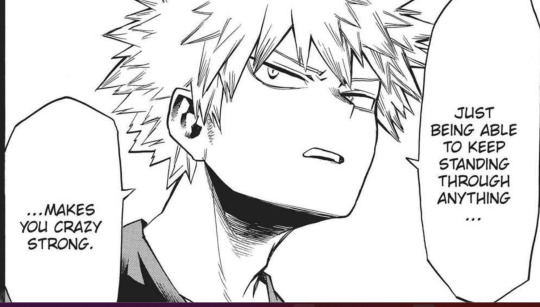
Bakugou's arc post-DvK2 becomes almost fully Deku-centric, while Kirishima gets an entirely new focus with Mina, with a backstory introduced during the Overhaul arc. So Kirishima's most important focus goes from being the deuteragonist's "sidekick/friend" to being the main focus of a tertiary, underdeveloped character, which post-Overhaul really negatively impacts his role in the story.
I think Horikoshi still tried to do right by him as a fan favourite, by giving him 3 Red Riot chapters, one of the only multi-chapters villain solo fights that non-Deku kids got, plus a very hype moment in the previous war. But while Kirishima stays as Bakugou's friend in the sense that they sit next to each other or joke sometimes,

these interactions become rare, and also lacking emotional depth and are used increasingly as comic relief. Also, post-war a lot of even more serious KiriBaku interactions are not focused on themselves, but in a way mainly on Todoroki.


I think Horikoshi did set up Kirishima and Mina having a deeper emotional bonding around Midnight's death and facing Gigantomachia (which is a symbol of facing their fears), it's a plotline that got largely scrapped in Hori's hurry to finish the story, resulting in a really lacklustre "climax". So the KiriMina dynamic just never felt as deep or meaningful as the KiriBaku dynamic was.
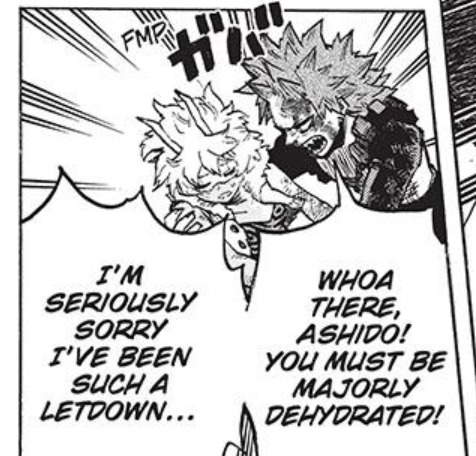
And yes, the Kirishima riding Machia cliffhanger was one of those bait panels that in the end didn't mean anything, only setting up Mina focus, just like Mina's color page back in the PLF war arc was setting up Kirishima's big moment.


So I guess that makes them even.
But still, after getting to the battlefield, Kirishima's contribution in the fight vs AFO was to shield Shinsou (when Shinsou wasn't even mindcontrolling Machia anymore) once.

Which I guess is a "feat", but was certainly made look less impressive by the fact that All Might's suit did the same trick like 5 times before it broke, while Kirishima went down in the 2nd hit.
I think for a guy, whose power is about "keep standing through anything", it is a pretty thin showing.
So is that it?
If it is, I guess people will say that Kirishima and Momo had their highlight in the PLF War arc and should be happy with that as "side characters". Of course, then you could ask what about Tokoyami?
If Class A gets more role - which is what I'm hoping for still as long as Aizawa-Kurogiri are still in play - then all these second-line important characters in the class, who at the moment has got severely reduced roles like Kirishima, Tsuyu, Iida and Momo may get another moment and a more hype way to finish off their arcs. It would be really neat to revisit the old friendships and bonds.
As someone who loves Class A, I'm really rooting for this, but of course there is no way of telling. Horikoshi has shafted them many times over, especially post PLF war. As much as Class A was the hype leading up to this final arc, I don't think he managed to do right by most of them and certainly not in the sense that would bring back the feeling of nostalgia of Act 1, where most of us fell in love with this story.
So given his track record (see Aoyama plotline) with class A, Horikoshi may think that sticking Class A into All Might's suit was a perfectly satisfying way to say goodbye to them. (Which makes me so sad and angry.)
47 notes
·
View notes
Text
for context: today's entry (june 30) is the end of chapter 4 of dracula as it's ordered in every print copy. "good-bye, all! mina!" is the last we hear of jonathan harker for a HOT minute; the first 4 chapters follow him exclusively, but chapter 5 switches over to the Greater London Polycule and contains all of the entries we've already read about mina, lucy, and the suitor squad.
we've all gotten the benefit of the slow build to this climax and the juxtaposition of jonathan in the Horror Plot and everyone else in the Romance Plot (+ jack and renfield doing... whatever you would call their interactions) but it's important to remember that anyone reading this book for the first time as it's printed (not chronologically as drac daily) spends a full chapter hanging out with jonathan, watching him slowly realize the gravity of his situation, sees his desperation, feels his fear and uncertainty as he scales the wall of the castle in a fleeting attempt to escape certain death...... and is then introduced to SIX NEW CHARACTERS in an ENTIRELY UNRELATED STORY ARC without knowing what happens to him. it's drama it's intrigue it's a little bit genius and, for all the benefits that the format of drac daily gives the narrative, i'm a bit sad that we miss that
#mina is the only common link between the two. she is VITAL to understanding what's happening#dracula#dracula daily#dd june 30#jonathan harker#mina murray#lucy westenra#arthur holmwood#quincey p morris#dr john seward#renfield#dracula meta#nat og#edit: this originally said chapter 2 was when we meet mina and lucy which was incorrect! it's been fixed sorry for the error
714 notes
·
View notes